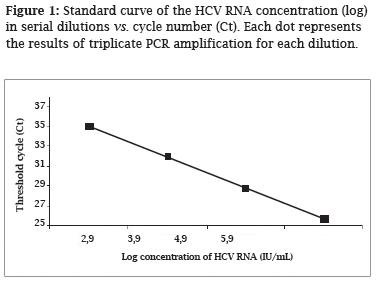BACKGROUND: Polymerase chain reaction (PCR) methods play an essential role in providing data related to diagnosis, monitoring and treatment of hepatitis C virus (HCV) infection. EIA results are reported as ''reactive'' or ''non reactive'' and EIA S/CO ratio may also be reported as ''high'' or ''low.'' This study aimed to evaluate the performance of a real-time RT-PCR and assess whether there is relationship between S/CO and PCR results. STUDY DESIGN AND METHODS: Sera from blood donors were analyzed by Enzyme-Linked Immunosorbent Assay (ELISA) and RT-PCR assay to detect HCV infection. RESULTS: The RT-PCR assay to genotypes 1a/b showed an acceptable linear response in serial dilutions. The samples were divided into two groups based on their serological results: group A - S/CO ratio < 3 (60 samples) and group B - S/CO ratio > 3 (41 samples). Viral loads were confirmed positive in group B samples in 90%, and in group A samples were confirmed positive in only 13% by RT-PCR. CONCLUSION: The methodology used was able to detect the presence of RNA-HCV genotype I in 90% of the samples serologically positive in group B. All negative samples were sent to search for other genotypes of HCV (genotypes 2-6) and were confirmed as negative. These data suggests that these negative samples may have HCV RNA viral load below the detection limit of our test (310 IU/ mL), or a false positive result in serological test, or spontaneous viral clearance occurred.
HCV; HCV genotype 1; real-time PCR; ELISA; RNA extraction




